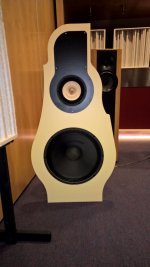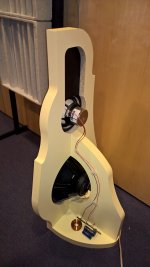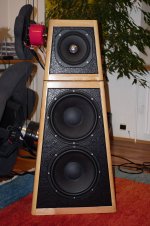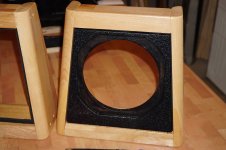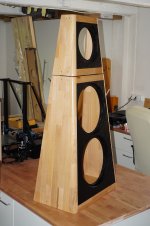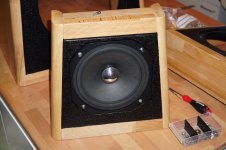Hello,
I need some help before starting my new project. I intend to make a woofer assisted full range dipole, using one 4.5 inch full range and two 12 inch woofers (per speaker)
Full range driver that would be used:
https://www.sonido.hu/adat_pdf/sfr-145a.pdf
Low frequency drivers to be used:
SB Acoustics SB34NRX75-16 12" Woofer, 16 ohm
The idea is to make a semi-passive dipole. I would like to add a first order crossover, since it's the simplest and offers phase coherence. All drivers would be fed the same signal from a single DA converter. Parametric equaliser would be used (whether by mini dsp, or inboard Linux tools) before DAC.
Possible baffle design would be similar to one from the link under. I have no idea how would this baffle design impact frequency response, so its open for changing.
http://www.pureaudioproject.com/cube-10-open-baffle-speakers/
I can source Sonido easily, so I'd like to build the system around it. Unsure about aforementioned SB drivers. They have pretty high inductance. How would two of those drivers' inductances affect the bass frequency and crossover? I've found cheaper drivers with less inductance, but they all tend to have high resonance frequency.
Also, since it's going to be a dipole, sonidos frequency is going to have downward slope towards lower frequency. I'm not sure how much of an overlap between the 4.5 inch and 12 inch drivers there would be and if a first order crossover would be usable. Maybe with some equalisation afterwards?
I'd really like that first order crossover, since a in-phase frequency response is a general idea behind this project. Other than that, the simpler, the better.
Thanks ahead.
Stefan
I need some help before starting my new project. I intend to make a woofer assisted full range dipole, using one 4.5 inch full range and two 12 inch woofers (per speaker)
Full range driver that would be used:
https://www.sonido.hu/adat_pdf/sfr-145a.pdf
Low frequency drivers to be used:
SB Acoustics SB34NRX75-16 12" Woofer, 16 ohm
The idea is to make a semi-passive dipole. I would like to add a first order crossover, since it's the simplest and offers phase coherence. All drivers would be fed the same signal from a single DA converter. Parametric equaliser would be used (whether by mini dsp, or inboard Linux tools) before DAC.
Possible baffle design would be similar to one from the link under. I have no idea how would this baffle design impact frequency response, so its open for changing.
http://www.pureaudioproject.com/cube-10-open-baffle-speakers/
I can source Sonido easily, so I'd like to build the system around it. Unsure about aforementioned SB drivers. They have pretty high inductance. How would two of those drivers' inductances affect the bass frequency and crossover? I've found cheaper drivers with less inductance, but they all tend to have high resonance frequency.
Also, since it's going to be a dipole, sonidos frequency is going to have downward slope towards lower frequency. I'm not sure how much of an overlap between the 4.5 inch and 12 inch drivers there would be and if a first order crossover would be usable. Maybe with some equalisation afterwards?
I'd really like that first order crossover, since a in-phase frequency response is a general idea behind this project. Other than that, the simpler, the better.
Thanks ahead.
Stefan
That SB is a great sub, but it's a sub that is ment to be used below 100-150Hz. For an OB that needs to crossover way above that i would use a different bass driver. Something like an Monacor SP-382PA or an Emminence Alpha 15A (a classic for this) is more fit for OB bass. Or the very expensive Acoustic Elegance Dipole models.
I think the SB Acoustics SB34NRX75-16 is very suitable for OB. Look datasheet. I do not like Alpha 15A. It has one note bass. Beta 15A is much much better.
I have a similar idea for OB - 3 x SB34NRX75-16 per channel and Sonido SWR 096 FC.
Thanks for an offer, but I'm not sure those would be right woofers for the job. If you cross them at say 400 hz, that would mean that a low pass filter would have lower inductance then the voice coil of one woofer. Their frequency response looks great for the application tho.
Last edited:
I can´t compare to many speakers other than a A&D R1524 (15" that is supposed to be better than the Alpha 15A) in a h-frame
but putting the Peerless 830669 on a flat&even narrow baffle was a definite improvement for my system. In my eyes it is excellent value for money.
I´m crossing it around 400Hz at the moment.
And besides it plays up into high frequencies very nicely.
Lot of people use it with just a tweeter which is maybe pushing it but just saying it works:
Fast, fun, Inexpensive OB project
but putting the Peerless 830669 on a flat&even narrow baffle was a definite improvement for my system. In my eyes it is excellent value for money.
I´m crossing it around 400Hz at the moment.
And besides it plays up into high frequencies very nicely.
Lot of people use it with just a tweeter which is maybe pushing it but just saying it works:
Fast, fun, Inexpensive OB project
The pro version of sba has what looks like a good candidate for OB bass. The Bianco 15
Which version are you referring to? This one?
BIANCO-15OB350
Update - just ordered Sonido 145a 
Peerless is too small to be used just one. Can you share more info on your crossover design??
I can´t compare to many speakers other than a A&D R1524 (15" that is supposed to be better than the Alpha 15A) in a h-frame
but putting the Peerless 830669 on a flat&even narrow baffle was a definite improvement for my system. In my eyes it is excellent value for money.
I´m crossing it around 400Hz at the moment.
And besides it plays up into high frequencies very nicely.
Lot of people use it with just a tweeter which is maybe pushing it but just saying it works:
Fast, fun, Inexpensive OB project
Peerless is too small to be used just one. Can you share more info on your crossover design??
https://www.diyaudio.com/forums/multi-way/110583-fast-fun-inexpensive-ob-project-127.html#post6535877
See here at posts 2524&2526. Still not perfect but I´m getting there.
Mini-DSP with LR12dB-crossover at~400Hz.
I use a HP on the woofer to limit excursion (which I never use that much anyway) that has a slight bump below 80dB to compensate for some dipole loss.
(I have reduced that "bump" you see in the picture to about +3dB since then)
At my usual listening levels this is more than fine and the woofer has room for lots of EQ at those SPL.
If you have a big room, long distance between you and the speakers and or want to throw loud parties you´d definitely be better off with 2x830669 but I´m just fine. I could have bought a second pair very cheaply and decided against it.
The SB Bianco series also have a 12" woofer that costs a little more than half of that 15".
SB Audience Bianco 12OB150 Open Baffle | Speakerbuddies Lautsprecheshop
Might be worth using 1-2 of those per side as an alternative.
Don´t know about availability though.
See here at posts 2524&2526. Still not perfect but I´m getting there.
Mini-DSP with LR12dB-crossover at~400Hz.
I use a HP on the woofer to limit excursion (which I never use that much anyway) that has a slight bump below 80dB to compensate for some dipole loss.
(I have reduced that "bump" you see in the picture to about +3dB since then)
At my usual listening levels this is more than fine and the woofer has room for lots of EQ at those SPL.
If you have a big room, long distance between you and the speakers and or want to throw loud parties you´d definitely be better off with 2x830669 but I´m just fine. I could have bought a second pair very cheaply and decided against it.
The SB Bianco series also have a 12" woofer that costs a little more than half of that 15".
SB Audience Bianco 12OB150 Open Baffle | Speakerbuddies Lautsprecheshop
Might be worth using 1-2 of those per side as an alternative.
Don´t know about availability though.
Hello,
I need some help before starting my new project. I intend to make a woofer assisted full range dipole, using one 4.5 inch full range and two 12 inch woofers (per speaker)
Full range driver that would be used:
https://www.sonido.hu/adat_pdf/sfr-145a.pdf
Low frequency drivers to be used:
SB Acoustics SB34NRX75-16 12" Woofer, 16 ohm
The idea is to make a semi-passive dipole. I would like to add a first order crossover, since it's the simplest and offers phase coherence. All drivers would be fed the same signal from a single DA converter. Parametric equaliser would be used (whether by mini dsp, or inboard Linux tools) before DAC.
Possible baffle design would be similar to one from the link under. I have no idea how would this baffle design impact frequency response, so its open for changing.
http://www.pureaudioproject.com/cube-10-open-baffle-speakers/
I can source Sonido easily, so I'd like to build the system around it. Unsure about aforementioned SB drivers. They have pretty high inductance. How would two of those drivers' inductances affect the bass frequency and crossover? I've found cheaper drivers with less inductance, but they all tend to have high resonance frequency.
Also, since it's going to be a dipole, sonidos frequency is going to have downward slope towards lower frequency. I'm not sure how much of an overlap between the 4.5 inch and 12 inch drivers there would be and if a first order crossover would be usable. Maybe with some equalisation afterwards?
I'd really like that first order crossover, since a in-phase frequency response is a general idea behind this project. Other than that, the simpler, the better.
Thanks ahead.
Stefan
Hi Stefan,
A few thoughts about your ideas:
- Your design will not be a true dipole design, as it will not have figure-8 dispersion above middle range. But that doesn´t matter, it´s nitpicking. The theory behind OB and dipole designs is nicely explained on Rudolf´s pages (dipolplus.de).
- 2 SB34NRX75-16 in a decently sized OB will result in 82dB/2,8V/1m efficiency without room gain, -3dB around 35Hz. Not bad, at 8Ohm nominal, but will need a lot of power to come alive.
- 2 SB12OB150 in a decently sized OB will result in 90dB/2,8V/1m efficiency without room gain, -3dB around 45Hz. Not bad, 4Ohm nominal.
- Hoffmans Iron Law is valid for OBs as well. The lower you aim with a given size of baffle and woofer, the lower will thev resulting efficiency be.
- Don´t mix up realistic numbers as above (AJHorn has proven to be quite correct on OB predictions many times) with phantasy, you can´t cheat physics.
- The semi-passive approach combines the negatives of both techniques. Once you have a passive filter in your system, try to optimize it instead of dsp. Or go with a good dsp solution and prepare for 2 amps. Either way, you´ll need time, decent measurements and your ears to succeed.
- First order passive CO is not phase coherent per se. The final result is what´s important.
- First order does not work with OB bass, as you have a 6dB/oct upwards slope with the bass. A single inductor will at best ease this, but for a defined filter function you need at least 2nd order.
- The FR driver response goes down south of a few hundred Hz, depending on baffle size. With a simple first order HP, the response will actually bounce back upwards at resonance, due to interaction with the C in series. That will result in damage to driver and filter function. You will have to correct the resonance impedance hump with an additional LCR. You will also have to correct the FR drivers inherent rising response and most possibly the breakup area to your taste.
- The PAP style baffle is, in my humble opinion, too large for the FR and too small for the woofers. And the FR fires at your knees and stomach, that makes for a funny 3-D representation...
Now on with a bit more positive thoughts and tips, not wanting to completely disencourage you...:
- As you have opted for the SFR145, have a look at Istvan´s SCW300. Not ideal for OB, but will result in 91dB/2,8V/1m with a -3dB around 50 Hz. Stylewise that´s your only choice... not cheap, and maximum level is a few dB less than the above solutions. Quality should be good and a good match for the 145 for sure.
- Make the FR baffle around 25cm max and aim for around 400Hz XO frequency.
- Make the woofer baffle as large as possible. An interesting idea is to have one woofer work up to 400Hz, the other one to add below 200Hz or so.
- Concentrate on either dsp of good quality (expensive and not easy, but possible) or passive XO of good quality (expensive and not easy, but possible). Don´t compromise good drivers with cheap dsp or wrong implemented XO.
- The baffle requirements for FR and woofer lead more or less automatically to a modular, or slanted, or trapezoidal baffle design. For inspiration, below a 2x12" woofer and 1x8"FR application which works fine. Passive XO.
Sorry if some of the above does not match your expectations... of course these are just my personal thoughts. YMMV, and you´re free to follow your own ideas...
All the best
Mattes
Attachments
It is discouraging, but it's a good place to start.
I find active DSP crossovers too complicated to implement (expensive?) with higher quality equipment. I'll go for a passive 2nd order then. I've been doing some reading from Martin J King, who also recommended 200ish Hz and 400 Hz for full range. He seems to blend a higher sensitivity woofer with a crossover, to match the sensitivity of full range driver.
How do you make those predictions of how low response at a given dB? May I ask you to comment on performance of SBA-15OB350? I decided to go with one woofer, for the sake of simplicity and cost. Also, why do you say that SWR 300 should be the only choice?
Swr is somewhat smaller, has lower dB than 15OB350, less xmax and lower Qts. I like the idea using of both drivers from Istvan, but I'd have to order swr in the next few days, since I already contacted him about SFR.
I'll try to put something trapezoidal into edge sim and see how it works out. If a lower high speaker was angled back, would it still make for a funny 3d representation?
Thanks a lot for posting!!
I find active DSP crossovers too complicated to implement (expensive?) with higher quality equipment. I'll go for a passive 2nd order then. I've been doing some reading from Martin J King, who also recommended 200ish Hz and 400 Hz for full range. He seems to blend a higher sensitivity woofer with a crossover, to match the sensitivity of full range driver.
How do you make those predictions of how low response at a given dB? May I ask you to comment on performance of SBA-15OB350? I decided to go with one woofer, for the sake of simplicity and cost. Also, why do you say that SWR 300 should be the only choice?
Swr is somewhat smaller, has lower dB than 15OB350, less xmax and lower Qts. I like the idea using of both drivers from Istvan, but I'd have to order swr in the next few days, since I already contacted him about SFR.
I'll try to put something trapezoidal into edge sim and see how it works out. If a lower high speaker was angled back, would it still make for a funny 3d representation?
Thanks a lot for posting!!
Last edited:
If you want to keep costs down you should either go for a proven design (crossover is done for you; buy components once),I find active DSP crossovers too complicated to implement (expensive?) with higher quality equipment.
or go active.
Making your own passive design can quickly become more expensive than say a minidsp 2x4hd or even cheaper active xo´s.
Or you find somebody that simulates the design for you (with martin king open baffle sheets for example)
Going active with mini DSP relies on converting analogue signal to digital for processing and then the same process in reverse, all by using cheap tech. What's the point on using high quality amplification and DACs , if half of sonic quality would be lost.
The only way I see it would be using digital crossover and then feeding the signal into separate DACs and amps, so double the amount of equipment for a two way speakers. Not to mention a hassle with digital volume adjustment ...
The only way I see it would be using digital crossover and then feeding the signal into separate DACs and amps, so double the amount of equipment for a two way speakers. Not to mention a hassle with digital volume adjustment ...
Going active with mini DSP relies on converting analogue signal to digital for processing and then the same process in reverse, all by using cheap tech. What's the point on using high quality amplification and DACs , if half of sonic quality would be lost.
The only way I see it would be using digital crossover and then feeding the signal into separate DACs and amps, so double the amount of equipment for a two way speakers. Not to mention a hassle with digital volume adjustment ...
Well... we kinda live in digital age, if you source music from streaming service/PC, it is already digital. audiosciencereview.com has many nice DACs reviewed, with surprising results.
Disclaimer: I do not own miniDSP, but plan to. The idea to have all the possible crossovers at once is very intriguing.
I had an OB with the Eminence Beta 15 for the bass, and Visaton B200 FR.
Trying to make it work by passive components, was a waste of time and money.
Finally, active analog was the answer. I bulit a crossover exactly as here:
https://www.google.com/url?sa=t&sou...FjAAegQIBRAC&usg=AOvVaw2H6X1CSsMcEPPL9Lc6tcMM
Around 80Hz low pass, second order. 160 HZ hi pass, second order as well. A Bit of EQ embedded into the crossover. Pass F2 amp for the FR, SS Sony for the woofers.
Just my 2Cents
Trying to make it work by passive components, was a waste of time and money.
Finally, active analog was the answer. I bulit a crossover exactly as here:
https://www.google.com/url?sa=t&sou...FjAAegQIBRAC&usg=AOvVaw2H6X1CSsMcEPPL9Lc6tcMM
Around 80Hz low pass, second order. 160 HZ hi pass, second order as well. A Bit of EQ embedded into the crossover. Pass F2 amp for the FR, SS Sony for the woofers.
Just my 2Cents
i don´t think the minidsp is that bad but yeah, you have to watch the gain structure. there are probably better dsp´s out there that are can work with higher signal amplitudes or have built in volume control.
tweaking obviously is more complicate of course if you wanna change xo-frequencies.
there are cheap PCBs out there for stereo 2-way crossovers with opamps.
or you can go discrete like I intend to in order to exchange the minidsp at one point:
Discrete crossover, sanity check
just ordered 5 PCBs. if you don´t mind populating them you can have one.
that´s a very good solution if one doesn´t mind soldering.Finally, active analog was the answer. I bulit a crossover exactly as here:
tweaking obviously is more complicate of course if you wanna change xo-frequencies.
there are cheap PCBs out there for stereo 2-way crossovers with opamps.
or you can go discrete like I intend to in order to exchange the minidsp at one point:
Discrete crossover, sanity check
just ordered 5 PCBs. if you don´t mind populating them you can have one.
- Home
- Loudspeakers
- Full Range
- WAW dipole
